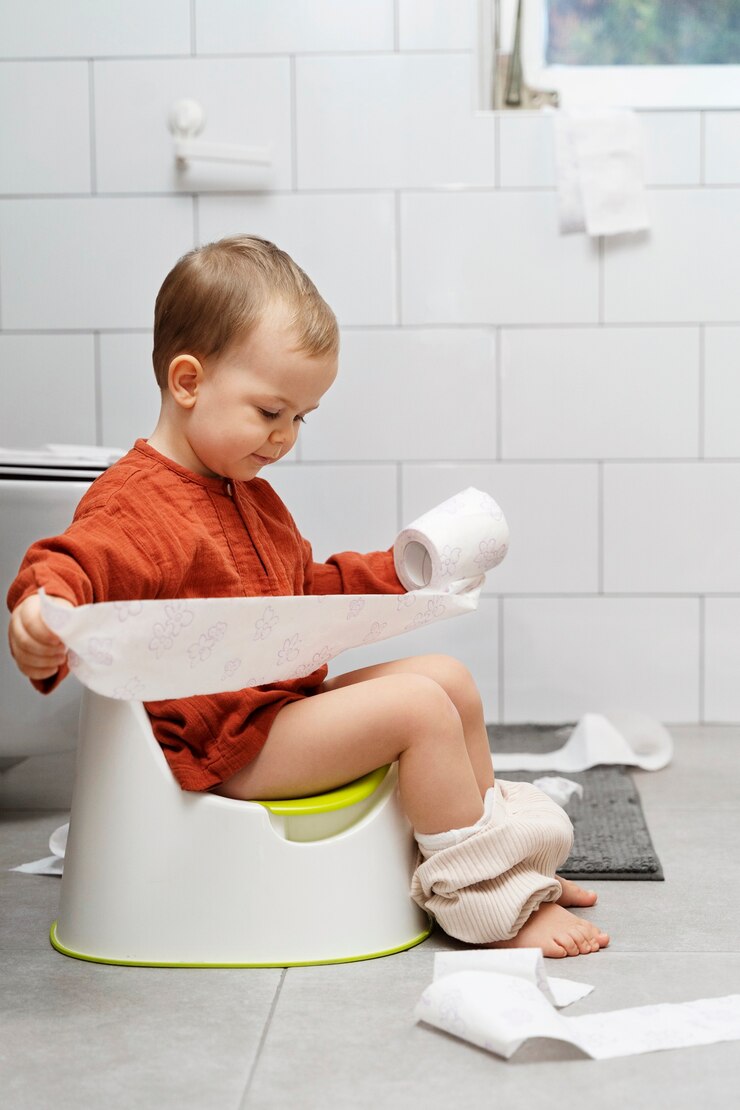 Paediatrician Thomas Berry Brazelton has proposed a “child-centred” approach to potty training: the child becomes the active player in the whole process and parents have to wait until the child is ready to leave the nappy behind (by detecting certain signs of his willingness and awareness), without rushing or pressurising.
Paediatrician Thomas Berry Brazelton has proposed a “child-centred” approach to potty training: the child becomes the active player in the whole process and parents have to wait until the child is ready to leave the nappy behind (by detecting certain signs of his willingness and awareness), without rushing or pressurising.
The first stage of this journey is to observe the child to see if he or she is ready to start on this path of ‘weaning from the nappy’ that will lead him or her to greater autonomy... but we need to wait for the right moment to start the journey.
We will need time (haste is not a good counsellor!) and gradualness, and the type of relationship we establish with our child, listening to their needs and proposing different experiences will be very important.
THE RIGHT TIME
There is no precise age that is the same for all children: most recognise the signals (such as the feeling of a full bladder) at around 2-3 years of age ... with a wide variability up to 5 years.
Typically, children begin to have sphincter control at around 18 months of age, so they remove their nappies at an average age of 24 months and complete nappy weaning at around 27 months; girls before boys.
At the same time, experiences that refer to early, assisted potty training are becoming more widespread: from the first months of life, parents, without coercion or punishment, can help the child in the process of urination and defecation, and this will enable the child to be autonomous very early on.
SIGNS
Parents should pay attention to certain signs and in their presence allow the child to become familiar with the potty, so that its use becomes a familiar, everyday gesture:
- the child wants to ‘behave like a grown-up’, imitating the behaviour of parents or an older sibling (so it is important to allow them to observe us and thus learn ‘how it is done’);
- is intrigued by going to the toilet;
- can walk and sit on his own;
- can raise and lower his trousers on his ow;
- feels the urge to urinate or evacuate in advanc;
- communicates his need to pee to the parent in time;
- can also say NO when he feels no urge
- has ‘dry periods’ of 3-4 hours;
- is annoyed by the feeling of a dirty nappy and asks to be changed.
Don't worry if you have difficulty taking off the nappy or if there are ups and downs. Potty training is a commitment, both for children and parents.
Your child may take steps backwards (resistance to weaning, fear of the toilet, refusal to go to the toilet to empty his bowels, persistence of nocturnal enuresis). In this case the paediatrician or an educational consultant will be of support.
There is a not uncommon bathroom refusal syndrome that resolves over time and a more serious but very rare bathroom phobia.
HOW CAN WE HELP HIM?
It may sound strange to you, but allowing your child to experience the feeling of being bathed - and annoyed by it - will help him to understand what is happening to him.
Accompanying this transition by reading age-appropriate texts that present the mysterious journey to the potty in a fun and playful way will also undoubtedly support him.
Things not to do:
- show frustration
- insist on the topic
- tell the child "everyone we know no longer wears nappies"
- keep telling the child "you are a big boy, you shouldn't wear nappies any more"
- express disappointment if there is an accident
- make faces of disgust when emptying the potty
- exaggerate with praise
- continue the programme if the child is not psychologically ready
It is also very important to be careful:
- avoid having all the family's attention focused on getting rid of the nappy. Expectations and pressure on the child could make him feel uncomfortable, risking that he refuses to go on;
- remember that the farewell to the nappy is a delicate moment for the child: it should not be proposed at the same time as other changes or particularly demanding events (for example the entrance to school, the birth of a baby brother, a move, a bereavement in the family),
- avoid reproaches, punishments and blackmail, which only have counterproductive effects. Arm yourself with patience and a spare kit for natural “mishaps”. Beware of rewards: it is nice to celebrate an important growth milestone, but the greatest happiness for a child should be that of being able to do it on his own, like the older ones he sees around him;
- if your child attends the crèche, discuss it with the facility's staff in order to act consistently without causing him confusion;
- be serene and always trust your child: if he feels he can do it, he will grow up free and happy.
GOOD RULES
- during the first attempts, help him by asking him if he has to pee at regular intervals, e.g. every 30 minutes;
- encourage and positively reinforce him: praise him when he does the right thing but do not emphasise when something goes wrong;
- dress your child in clothes that are easy to pull down and up, avoiding zips, buttons, and tear-off fastenings so that he can do it himself (or with your help, when he really can't);
- teach your child to wash and dry his hands.
IF THE CHILD CANNOT REMOVE THE NAPPY
It may happen that a child cannot remove his or her nappy because of too frequent urination, or urgent urge that he or she cannot hold back and control.
In these cases, it is a good idea to consult one's paediatrician and possibly a paediatric urology specialist to rule out any congenital anomalies or functional disorders. These are non-invasive examinations and examinations that help to understand the dysfunction and find the remedy or a cure.
Weaning from the nappy and learning to use the potty during the day is generally easier and more regular, but the child may continue to wet the bed at night, even after the age of 4-5. This phenomenon is called nocturnal enuresis and can be totally independent of the ability to pee on command during the day. It is a waking disorder or related to the abundant production of urine during the night. After the age of 6, the phenomenon must be addressed, knowing that there are remedies to help resolve it more quickly.


